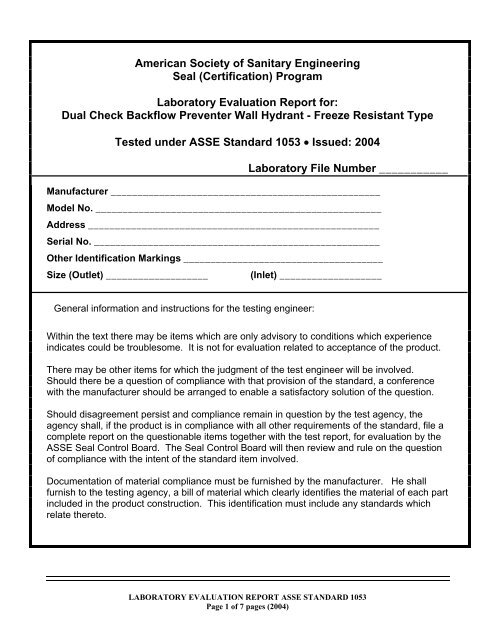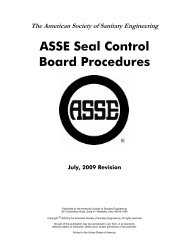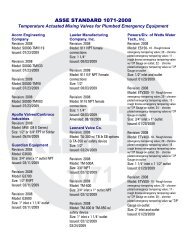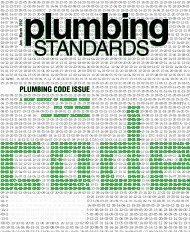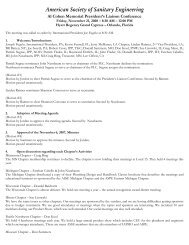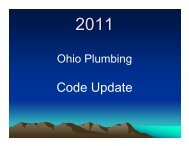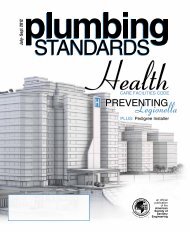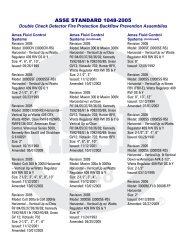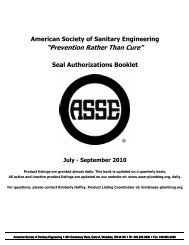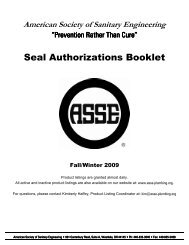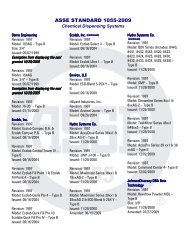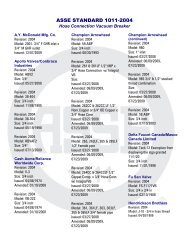1053 - American Society of Sanitary Engineering
1053 - American Society of Sanitary Engineering
1053 - American Society of Sanitary Engineering
Create successful ePaper yourself
Turn your PDF publications into a flip-book with our unique Google optimized e-Paper software.
<strong>American</strong> <strong>Society</strong> <strong>of</strong> <strong>Sanitary</strong> <strong>Engineering</strong><br />
Seal (Certification) Program<br />
Laboratory Evaluation Report for:<br />
Dual Check Backflow Preventer Wall Hydrant - Freeze Resistant Type<br />
Tested under ASSE Standard <strong>1053</strong> Issued: 2004<br />
Laboratory File Number ___________<br />
Manufacturer __________________________________________________<br />
Model No. _____________________________________________________<br />
Address ______________________________________________________<br />
Serial No. _____________________________________________________<br />
Other Identification Markings _____________________________________<br />
Size (Outlet) ___________________ (Inlet) ___________________<br />
General information and instructions for the testing engineer:<br />
Within the text there may be items which are only advisory to conditions which experience<br />
indicates could be troublesome. It is not for evaluation related to acceptance <strong>of</strong> the product.<br />
There may be other items for which the judgment <strong>of</strong> the test engineer will be involved.<br />
Should there be a question <strong>of</strong> compliance with that provision <strong>of</strong> the standard, a conference<br />
with the manufacturer should be arranged to enable a satisfactory solution <strong>of</strong> the question.<br />
Should disagreement persist and compliance remain in question by the test agency, the<br />
agency shall, if the product is in compliance with all other requirements <strong>of</strong> the standard, file a<br />
complete report on the questionable items together with the test report, for evaluation by the<br />
ASSE Seal Control Board. The Seal Control Board will then review and rule on the question<br />
<strong>of</strong> compliance with the intent <strong>of</strong> the standard item involved.<br />
Documentation <strong>of</strong> material compliance must be furnished by the manufacturer. He shall<br />
furnish to the testing agency, a bill <strong>of</strong> material which clearly identifies the material <strong>of</strong> each part<br />
included in the product construction. This identification must include any standards which<br />
relate thereto.<br />
LABORATORY EVALUATION REPORT ASSE STANDARD <strong>1053</strong><br />
Page 1 <strong>of</strong> 7 pages (2004)
Product Name _______________________________________________________________<br />
Model Number _______________________________ Size(s) ____________________<br />
Date Submitted for Review _____________ Date Review Complete _____________<br />
Were the test units production models Yes No<br />
Section I<br />
Or prototypes? Yes No<br />
1.0 General<br />
1.1 Application<br />
Does this device, as stated by the manufacturer, comply with this section?<br />
Yes <br />
No <br />
Questionable<br />
If questionable, explain: ________________________________________________________<br />
1.2 Scope<br />
Does the device conform to the product classified as a dual check backflow preventer wall<br />
hydrant-freeze resistant type? Yes <br />
No <br />
Questionable<br />
If questionable, explain: ________________________________________________________<br />
1.2.1 Description.<br />
Is this hydrant a Type 'A' or Type 'B' device? Type 'A' <br />
Type 'B'<br />
1.2.2 Size Range.<br />
1.2.2.1 Size <strong>of</strong> male hose threaded outlet: _______inches _______ (mm).<br />
1.2.2.2 Size <strong>of</strong> inlet: _______ inches _______ (mm).<br />
1.2.4 Pressure.<br />
What is the maximum working pressure as noted by the manufacture?<br />
_______psi ( _______kPa).<br />
1.2.5 Temperature Range.<br />
What is the temperature range as noted by the manufacturer?<br />
_______°F to _______°F (_______°C to _______°C)<br />
1.2.7 Atmospheric Port.<br />
Is the atmospheric port a non-standard plumbing connection? Yes <br />
No<br />
LABORATORY EVALUATION REPORT ASSE STANDARD <strong>1053</strong><br />
Page 2 <strong>of</strong> 7 pages (2004)
Section II<br />
2.0 Test Specimens<br />
2.1 Samples Submitted for Test.<br />
How many devices <strong>of</strong> each type or model and size were submitted for testing?______________<br />
What is the length <strong>of</strong> the hydrant? _______inches ( _______mm)<br />
Is this the smallest inlet and longest length <strong>of</strong> the hydrant series? Yes <br />
No<br />
Were the test performed in the order as described in this standard? Yes <br />
No<br />
2.2 Samples Tested.<br />
How many devices <strong>of</strong> each type or model were utlized during the laboratory evaluation? _______<br />
If more than one device was used, explain why: _______________________________________<br />
2.3 Drawings.<br />
Were assembly drawings, installation drawings and other technical data which are needed to<br />
enable a testing agency to determine compliance with this standard submitted with the devices? <br />
Yes <br />
No<br />
Were the drawings reviewed in the laboratory? Yes <br />
No <br />
<br />
Section III<br />
Performance Requirements and Compliance Testing<br />
3.1 Hydrostatic Pressure Tests<br />
What was the test pressure? _______psi (_______kPa)<br />
The test period was for _______ minutes.<br />
In compliance? Yes <br />
No <br />
3.2 Water Flow Capacity and Pressure Loss.<br />
What was the supply pressure used for this test? _______psi ( _______ kPa)<br />
At a 25 psi (172.4 kPa) pressure differential across the device, what was the flow rate?<br />
_______ GPM ( _______L/s)<br />
In compliance? Yes <br />
No <br />
Questionable<br />
If questionable, explain: ________________________________________________________<br />
<br />
3.3 Deterioration at Maximum Rated Temperature and Pressure.<br />
What was the water temperature used for this test? _______ °F ( _______ °C)<br />
What was the supply pressure used for this test? _______ psi ( _______kPa)<br />
Duration <strong>of</strong> test: _______ hours/day for _______ days<br />
In compliance? Yes <br />
No<br />
3.4 Life Cycle Test.<br />
How many cycles were used for this evaluation?_______cycles<br />
LABORATORY EVALUATION REPORT ASSE STANDARD <strong>1053</strong><br />
Page 3 <strong>of</strong> 7 pages (2004)
What was the dwell time per cycle? _______seconds<br />
In compliance? Yes <br />
No<br />
3.5 Resistance to Bending.<br />
Load applied _______ lbs.( _______ kg)<br />
Supply pressure used for this test? _______psi (_______ kPa)<br />
Duration <strong>of</strong> test: _______minutes<br />
In compliance? Yes <br />
No<br />
3.6 Self-Drain Capabilities<br />
Did the Type 'A' device discharge 3.0 gallons (11.4 liters) <strong>of</strong> water after the base temperature was<br />
lowered to 0.0°F (-17.8°C) and the hose was removed?<br />
Yes <br />
No<br />
Did the Type 'B' device discharge 3.0 gallons (11.4 liters) <strong>of</strong> water after the base temperature was<br />
lowered to 0.0°F (-17.8°C) and the hose and nozzle were left attached?<br />
Yes <br />
No<br />
In compliance? Yes <br />
No <br />
Questionable<br />
If questionable, explain: _______<br />
3.7 Tightness <strong>of</strong> Outlet Check Valve.<br />
Was the inlet check valve blocked open and were the atmospheric vents sealed close?<br />
Yes <br />
No<br />
Begining height <strong>of</strong> water in the sight glass: _______ inches (_______ mm)<br />
Final height <strong>of</strong> water in the sight glass: _______inches ( _______ mm)<br />
Water was held in the sight glass for _______ minutes<br />
In compliance? Yes <br />
No <br />
<br />
3.8 Tightness <strong>of</strong> Inlet Check Valve.<br />
Was the outlet check valve blocked open and were the atmospheric vents sealed close?<br />
Yes <br />
No<br />
Begining height <strong>of</strong> water in the sight glass: _______inches (_______mm)<br />
Final height <strong>of</strong> water in the sight glass: _______inches ( _______ mm)<br />
Water was held in the sight glass for _______ minutes<br />
In compliance? Yes <br />
No<br />
3.9 Leakage from Vent Ports.<br />
What was the supply pressure used for this test? _______ psi ( _______ kPa)<br />
Was there any leakage at the vent ports at full flow? Yes <br />
No <br />
Questionable<br />
LABORATORY EVALUATION REPORT ASSE STANDARD <strong>1053</strong><br />
Page 4 <strong>of</strong> 7 pages (2004)
If questionable, explain: ________________________________________________________<br />
3.10 Backflow Through Inlet Check Valve.<br />
Was there any loss <strong>of</strong> water level in the sight glass or leakage through the inlet check valve?<br />
At 6 inches (152.4 mm) water column? Yes <br />
No<br />
Duration <strong>of</strong> test:_______minutes<br />
At 10 feet (3.0 meters) water column? Yes <br />
No<br />
Duration <strong>of</strong> test:_______minutes<br />
In compliance? Yes <br />
No <br />
3.11 Backflow Through Outlet Check Valve.<br />
Was there any loss <strong>of</strong> level in the sight glass or leakage through the inlet check valve<br />
At 6.0 inches (152.4 mm) <strong>of</strong> water column Yes <br />
No <br />
Duration <strong>of</strong> test: _______minutes<br />
At 10.0 feet (3.0 M) <strong>of</strong> water column Yes <br />
No<br />
Duration <strong>of</strong> test:_______minutes<br />
At 250 psi (1723.8 kPa) or two (2) times the manufacturer's maximum rated pressure, whichever<br />
is greater? Yes <br />
No<br />
Duration <strong>of</strong> test: _______ minutes<br />
In compliance? Yes <br />
No<br />
3.12 Backsiphonage.<br />
Check valves were fouled by which method:__________________________________________<br />
What was the size <strong>of</strong> the wire used to foul the check valves? _______ inches ( _______ mm)<br />
Was there any rise <strong>of</strong> water in the sight glass during sequence steps (1), (2), or (3) <strong>of</strong> Section<br />
3.12.2?<br />
Yes <br />
No<br />
In compliance? Yes <br />
No<br />
3.13 Backsiphonage and Backpressure.<br />
Inlet check valve was fouled by which method: ________________________________________<br />
Was there any flow <strong>of</strong> water from the outlet into the inlet piping during sequence steps (1), (2) or<br />
(3) <strong>of</strong> Section 3.13.2? Yes <br />
No<br />
Outlet check valve was fouled by which method: ______________________________________<br />
Was there any flow <strong>of</strong> water from the outlet into the inlet piping during sequence steps (1), (2) or<br />
(3) <strong>of</strong> Section 3.13.2? Yes <br />
No<br />
In compliance? Yes <br />
No<br />
LABORATORY EVALUATION REPORT ASSE STANDARD <strong>1053</strong><br />
Page 5 <strong>of</strong> 7 pages (2004)
3.14 Relief <strong>of</strong> Intermediate Chamber Pressure.<br />
What pressure was used for this test? _______ psi ( _______ kPa)<br />
Did the atmospheric vents open and dissipate the intermediate chamber pressure by discharging<br />
water when the inlet pressure dropped to atmospheric? Yes <br />
No<br />
In compliance? Yes <br />
No<br />
Section IV<br />
4.0 Detailed Requirements<br />
4.1 Materials.<br />
Was the lead content in solders and fluxes 0.2% or less? Yes <br />
No <br />
Was the lead content in the metal alloys 8% or less? Yes <br />
No<br />
4.1.1 Metallic Parts<br />
Do the metal parts except springs have a corrosion resistance equal to a copper alloy <strong>of</strong><br />
not less than 58% copper? Yes <br />
No<br />
4.1.2 Springs<br />
Do the springs have a corrosion resistance equal to chrome nicke staninless steel, series<br />
300?<br />
Yes <br />
No<br />
4.1.4 Metal to Metal Seating<br />
Do either the check valves or relief means venting have metal to metal seats?<br />
Yes <br />
No<br />
4.2 Instructions for Markings.<br />
4.2.1 What markings appear on the device?<br />
_____________________________________________________________________________<br />
4.2.2 How are the markings applied?<br />
_____________________________________________________________________________<br />
4.3 Installation Instructions.<br />
Were installation instructions packaged with the device? Yes <br />
No<br />
LABORATORY EVALUATION REPORT ASSE STANDARD <strong>1053</strong><br />
Page 6 <strong>of</strong> 7 pages (2004)
TESTING AGENCY ________________________________________________________<br />
ADDRESS _______________________________________________________________<br />
PHONE: ______________ FAX: ______________<br />
TEST ENGINEER(S) _______________________________________________________<br />
We certify that the evaluations are based on our best judgments and that the test data recorded is an accurate<br />
record <strong>of</strong> the performance <strong>of</strong> the device on test.<br />
Signature <strong>of</strong> the <strong>of</strong>ficial <strong>of</strong> the agency: ______________________________________________________<br />
Title <strong>of</strong> the <strong>of</strong>ficial: _________________________________________ Date: _____________________<br />
Signature and seal <strong>of</strong> the Registered Pr<strong>of</strong>essional Engineer<br />
supervising the laboratory evaluation:<br />
______________________________________________<br />
Signature<br />
Seal<br />
LABORATORY EVALUATION REPORT ASSE STANDARD <strong>1053</strong><br />
Page 7 <strong>of</strong> 7 pages (2004)


